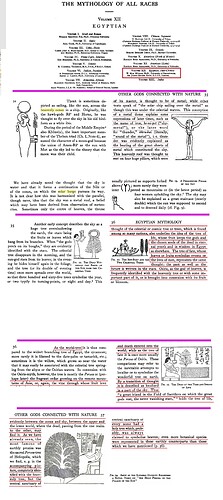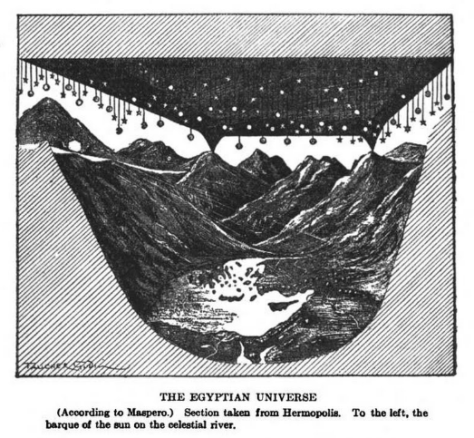@Jon_Garvey,
I’m not really sure what your post is trying to say. So I thought I would get clarification from this site below. I found it to be quite impressive!!!
Below is a lengthy section on Egyptian literature and a brief note below that on the Greeks.
At the link, there is also a long treatment on the Hebrew view. I haven’t had a chance to read that section yet, but I did notice a lot of references to rabbis.
At the very least, the Egyptian references the site uses seem modern enough!
^^^^^^^^^^^^^^^^^^^^^^^^^^^^^^^^^^^^^^^^^^^^^^^^^^^^^^
^^^^^^^^^^^^^^^^^^^^^^^^^^^^^^^^^^^^^^^^^^^^^^^^^^^^^^
Egyptian Literature
The ancient Egyptians had a strong sense of symmetry and balance. A sky above meant that there must be a sky below. Each god had his goddess. Heaven was an ocean that paralleled the earthly ocean. The sun sailed in a ship across the heavenly ocean. They believed that there was a nocturnal ocean beneath the world on which the sun would sail at night. Boats have been dug up around the Great Pyramid so the king would have a boat to sail on the heavenly ocean.
The Pyramid Texts are the oldest Egyptian writings. They are very short, and are mainly concerned with the destiny of the dead in order that they might dwell in the sky like the gods. They could journey with the sun-god in his ship, or live in the fields of the Blessed, the Field of Food-Offerings, or the Field of Iaru. There are many utterances that have been written on the Pyramids. Here are some excerpts from the texts about their view on heaven (Faulkner 1969).
Set the rope aright, cross the Milky Way(?), smite the ball in the meadow if Apis! Oho! Your fields are in fear, you izd-star, before the Pillar of the Stars, for they have seen the Pillar of Kenzet, the Bull of the sky, and the Ox-herd is overwhelmed before him. Ho! Fear and tremble, you violent ones who are on the storm-cloud of the sky! He split open the earth by means of what he knew on the day when he wished to come thence (Utterance 254).
The king takes possession of the sky, he cleaves its iron (Utterance 257).
Stand up, remove yourself, O you who do not know the Thicket of Reeds, that I may sit in your place and row over the sky in your bark, O Re, that I may push off from the land in your bark, O Re. When you ascend from the horizon, my sceptre will be in my hand as one who rows your bark, O Re. You mount up to the sky, you are far from the earth, far from wife and kilt (Utterance 267).
If you wish to live, O Horus in charge of your staff of justice, then you shall not slam shut its door leaves before you have taken the king’s double to the sky (Utterance 440).
From these utterances one learns that there is a heavenly ocean with gates that keep the waters in, and the sun travels by boat across this ocean. There is a parallel underworld ocean and sky.
In utterance 257 the word for “iron” is better translated “bronze,” (Faulkner 1991, 80) which indicates that heaven was made of hard metal. Mercer (1952, 2:142) takes this as a figurative sense meaning “hardness” or “firmness.”
There are a number of drawings on Egyptian walls that explain their view of the world. In the Cenotaph of Seti I at Abydos there is a drawing of the universe on the ceiling in the sarcophagus chamber (Keel 1978, 32, 389). Shu, the god of the air, holds up Nut covered with stars. The sun is born again each morning from Nut’s birth canal, and is swallowed by her mouth at dusk which leads to the underworld. The underworld is both in heaven and under the earth. Those whose souls were lighter than the feather of righteousness could continue on to heaven while the others would be punished in pits of fire. The sun is drawn as a winged disk, and right beside it is written:
The majesty of this god [the sun god] enters the world of the dead through her mouth. The world of the dead is opened when he enters into it. The stars follow him into her and come out again after him, and they hasten to their place (Keel 1978, 32).
In a much later drawing from Ptolemy IX there are two heavens (Ibid., 34, 389). The lower heaven contained the moon while the upper one contained the sun. The Tuat is surrounded by the earth. Sometimes the earth is identified with the underworld. The Egyptian word for earth, t, and the Hebrew xra can designate the upper surface of the earth as well as the interior underworld (Keel, 35; Psalms 7:5, 44:25, 63:9).
A papyrus from the New Kingdom pictures the sky as a heavenly ocean on which the sun sails in its special boat. In the boat is Maat with a feather on her head sitting before the falcon-headed sun god. Maat symbolizes world order (Ibid., 36, 389).
There is a text that states that there are two heavens. There is the heaven that is above, and the heaven that is in the underworld on which the sun’s boats float. The text says:
(Thus) thou shalt be in thy shrine, thou shalt journey in the evening-barque, thou shalt rest in the morning-barque, thou shalt cross thy two heavens in peace, thou shalt be powerful, thou shalt live (ANET, 7).
Greek Literature
In ancient Greek literature heaven was described in similar terms as in the OT. Homer describes heaven several different ways. In Iliad heaven is described as calkeos (brass), and polucalkos (solid brass; LCL, 17:425, 5:504). The Odyssey also describes heaven as sidhreos, meaning “iron” (LCL, 1:2,3). According to Liddell and Scott (1857, 1068), the Greek heaven was like “a concave hemisphere resting on the verge of earth, with an opening in it, through which the peak of Olympus stretched upward into pure ether. It was upborne by the pillars of Atlas” (Odyssey 1:54).
http://www.bibleandscience.com/bible/books/genesis/genesis1_firmament.htm


